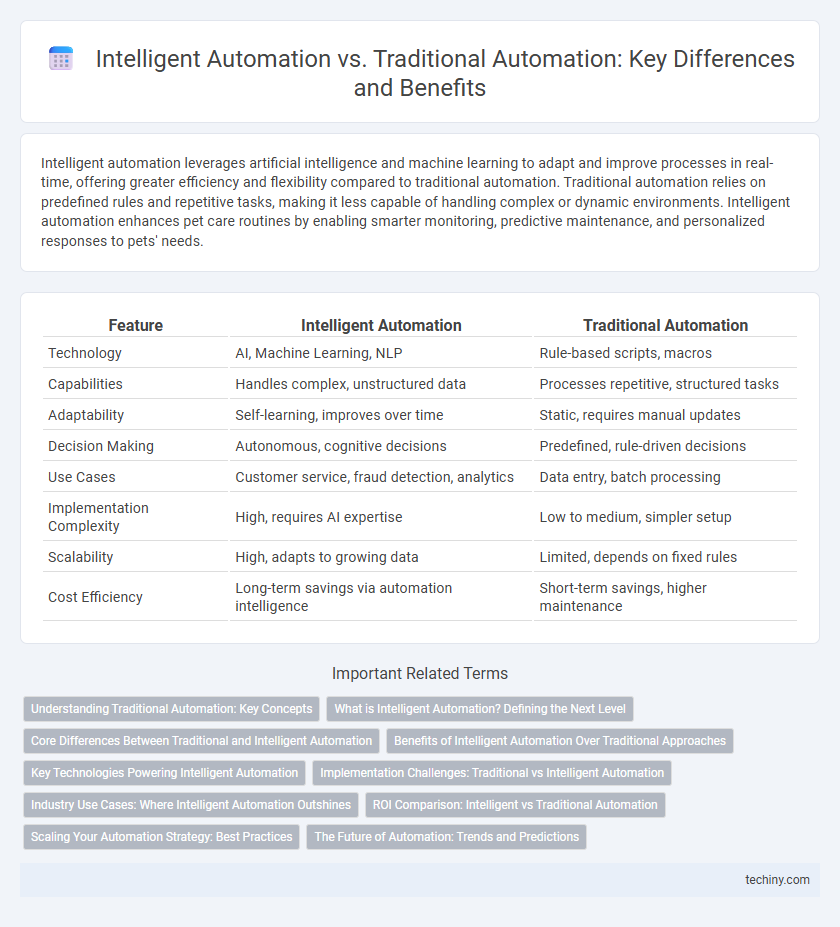Intelligent automation leverages artificial intelligence and machine learning to adapt and improve processes in real-time, offering greater efficiency and flexibility compared to traditional automation. Traditional automation relies on predefined rules and repetitive tasks, making it less capable of handling complex or dynamic environments. Intelligent automation enhances pet care routines by enabling smarter monitoring, predictive maintenance, and personalized responses to pets' needs.
Table of Comparison
| Feature | Intelligent Automation | Traditional Automation |
|---|---|---|
| Technology | AI, Machine Learning, NLP | Rule-based scripts, macros |
| Capabilities | Handles complex, unstructured data | Processes repetitive, structured tasks |
| Adaptability | Self-learning, improves over time | Static, requires manual updates |
| Decision Making | Autonomous, cognitive decisions | Predefined, rule-driven decisions |
| Use Cases | Customer service, fraud detection, analytics | Data entry, batch processing |
| Implementation Complexity | High, requires AI expertise | Low to medium, simpler setup |
| Scalability | High, adapts to growing data | Limited, depends on fixed rules |
| Cost Efficiency | Long-term savings via automation intelligence | Short-term savings, higher maintenance |
Understanding Traditional Automation: Key Concepts
Traditional automation relies on predefined, rule-based processes that execute repetitive tasks with minimal human intervention, primarily focusing on efficiency and consistency. It uses scripting, macros, or programmable logic controllers (PLCs) to perform specific functions in manufacturing and IT workflows. Understanding traditional automation involves recognizing its limitations in handling unstructured data and adapting to dynamic environments, which intelligent automation aims to overcome through AI and machine learning integration.
What is Intelligent Automation? Defining the Next Level
Intelligent Automation combines traditional automation techniques with artificial intelligence technologies such as machine learning, natural language processing, and computer vision to enhance decision-making and adaptability. Unlike traditional automation, which follows predefined rules and workflows, Intelligent Automation can analyze data, learn from patterns, and handle unstructured information, enabling more complex and dynamic processes. This next-level automation drives operational efficiency, reduces errors, and supports real-time responses in rapidly changing environments.
Core Differences Between Traditional and Intelligent Automation
Traditional automation relies on predefined rules and repetitive tasks to increase efficiency, while intelligent automation integrates artificial intelligence and machine learning to enable decision-making and adaptability. Core differences include traditional automation's static process execution versus intelligent automation's dynamic learning capabilities and ability to handle unstructured data. Intelligent automation also supports cognitive functions such as natural language processing and predictive analytics, which are absent in conventional automation frameworks.
Benefits of Intelligent Automation Over Traditional Approaches
Intelligent Automation leverages artificial intelligence, machine learning, and advanced analytics, enabling systems to adapt dynamically and handle complex tasks beyond rule-based processes used in Traditional Automation. This results in increased operational efficiency, reduced error rates, and enhanced scalability across diverse business functions. Enterprises deploying Intelligent Automation experience significant cost savings and faster decision-making compared to conventional automation approaches limited to repetitive, predefined workflows.
Key Technologies Powering Intelligent Automation
Intelligent Automation leverages advanced technologies such as artificial intelligence (AI), machine learning (ML), natural language processing (NLP), and robotic process automation (RPA) to enhance decision-making processes and handle unstructured data, unlike Traditional Automation which relies on rule-based scripting and repetitive task execution. Key technologies powering Intelligent Automation include AI-driven cognitive capabilities for understanding and interpreting complex data, ML algorithms that continuously improve through data analysis, and NLP enabling human-like interactions. These technologies collectively enable dynamic adaptation, increased accuracy, and scalability in business processes beyond the capabilities of conventional automation systems.
Implementation Challenges: Traditional vs Intelligent Automation
Traditional automation faces implementation challenges such as rigid programming, limited adaptability, and high maintenance costs, often requiring significant manual intervention for updates or error handling. Intelligent automation overcomes these limitations by integrating AI, machine learning, and cognitive technologies, enabling dynamic decision-making and seamless adaptation to changing environments. However, it demands complex data integration, skilled personnel, and higher initial investment, posing a steeper implementation hurdle compared to traditional automation systems.
Industry Use Cases: Where Intelligent Automation Outshines
Intelligent Automation integrates AI and machine learning to enhance decision-making, enabling industries like manufacturing and finance to optimize complex workflows and improve accuracy beyond the capabilities of Traditional Automation. In supply chain management, Intelligent Automation excels by predicting demand fluctuations and automating adaptive responses, whereas Traditional Automation typically handles repetitive, rule-based tasks without flexibility. Healthcare benefits significantly from Intelligent Automation through real-time data analysis and personalized patient care, surpassing the static processes managed by traditional systems.
ROI Comparison: Intelligent vs Traditional Automation
Intelligent Automation delivers significantly higher ROI compared to Traditional Automation by combining AI, machine learning, and advanced analytics to optimize processes and reduce manual intervention. While Traditional Automation offers cost savings through rule-based task execution, Intelligent Automation captures additional value by enabling decision-making capabilities and adaptability in complex workflows. Businesses adopting Intelligent Automation report up to a 3x faster ROI realization due to enhanced efficiency, error reduction, and scalability.
Scaling Your Automation Strategy: Best Practices
Intelligent Automation leverages AI, machine learning, and cognitive technologies to enhance decision-making and adapt processes dynamically, enabling scalable and flexible automation solutions beyond rule-based Traditional Automation. Scaling your automation strategy requires integrating intelligent workflows that can handle complex tasks, continuous monitoring to optimize performance, and robust governance frameworks to maintain compliance and security. Emphasizing collaborative human-automation interaction and investing in scalable infrastructure ensures sustainable growth and maximized ROI in automation initiatives.
The Future of Automation: Trends and Predictions
Intelligent Automation integrates AI, machine learning, and advanced analytics to enhance decision-making and adaptability, surpassing Traditional Automation's rule-based processes. Future trends indicate a shift towards increased cognitive capabilities, enabling automation systems to handle complex tasks and unstructured data autonomously. Predictions emphasize widespread adoption across industries, driving innovation, efficiency, and a new era of human-machine collaboration.
Intelligent Automation vs Traditional Automation Infographic

 techiny.com
techiny.com